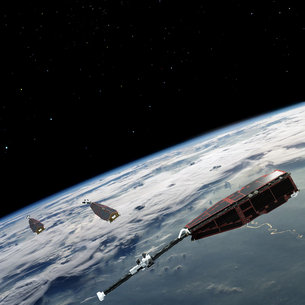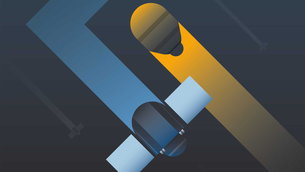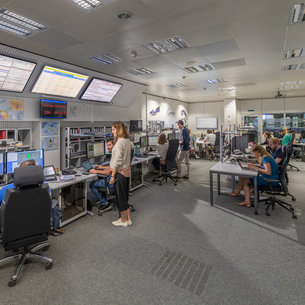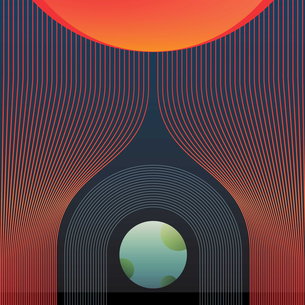18.05.2019

MISSION CONTROL 'SAVES SCIENCE'
Every minute, ESA’s Earth observation satellites gather dozens of gigabytes of data about our planet – enough information to fill the pages on a 100-metre long bookshelf. Flying in low-Earth orbits, these spacecraft are continuously taking the pulse of our planet, but it's teams on the ground at ESA’s Operations Centre in Darmstadt, Germany, that keep our explorers afloat.
From flying groups of spacecraft in complex formations to dodging space debris and navigating the ever-changing conditions in space known as space weather, ESA’s spacecraft operators ensure we continue to receive beautiful images and vital data on our changing planet.
Get in formation
Many Earth observation satellites travel in formation. For example, the Copernicus Sentinel-5P satellite follows behind the Suomi-NPP satellite (from the National Oceanic and Atmospheric Administration). Flying in a loose trailing formation, they observe parts of our planet in quick succession and monitor rapidly evolving situations. Together they can also cross-validate instruments on board as well as the data acquired.
ESA’s Earth Explorer Swarm satellites are another example of complex formation flying. On a mission to provide the best ever survey of Earth’s geomagnetic field, they are made up of three identical satellites flying in what is called a constellation formation.
Swarm’s individual satellites operate together under shared control in a synchronised manner, accomplishing the same objective of one giant – and more expensive – satellite.
“Formation flying has all the challenges of flying many single spacecraft, except with the added complexity that we need to maintain a regular distance between all of these high-speed and high-tech eyes on Earth,” explains Jose Morales Santiago, ESA’s Head of the Earth Observation Mission Operations Division.
“Every decision we make, every command we send, has to be the right one for each spacecraft – particularly when it comes to manoeuvres. These must be planned properly so that they do not endanger companion satellites, while keeping a consistent configuration across the formation.”
Saving science
Last year, ESA’s Earth observation missions performed a total of 28 ‘collision avoidance manoeuvres’. These manoeuvres saw operators send the orders to a spacecraft to get out of the way of an oncoming piece of space debris.
An impact with a fast-moving piece of space junk has the potential to destroy an entire satellite and in the process create even more debris. As a spacecraft ‘swerves’ to avoid collision, science instruments may need to be turned off to ensure their safety and avoid being contaminated by the thrusting engine.
Teams at mission control consider how to keep Europe’s fleet of Earth observers safe while maximising the vital work they are able to do. Recently, they came up with an ingenious concept to ‘save science’ during such manoeuvres of the Sentinel-5P satellite.
The Sentinel team quickly realised that during a collision avoidance manoeuvre they would have to suspend science collection for almost a day, because of the emergency firing of the thrusters.
“That’s a lot of data to miss out on. As the amount of space debris is currently increasing, this would be something we would need to do more and more often,” explains Pierre Choukroun, Sentinel-5P Spacecraft Operations Engineer, who came up with the fix.
“So we designed and validated a new on-board function to enhance the spacecraft’s autonomy, such that the science data loss is reduced to a bare minimum. We are very much looking forward to securing more data for the science community in the near future!”
With this new strategy, the science instruments on Sentinel-5P would be shut off for around on hour compared with an entire day!
Sun protection
As if dodging bits of space debris weren’t enough for Europe’s Earth explorers, they also have to navigate the turbulent weather conditions in space.
Space weather refers to the environmental conditions around Earth due to the dynamic nature of our Sun. The constant mood swings of our star influence the functioning and reliability of our satellites in space, as well as infrastructure on the ground.
When the Sun is particularly active, it adds extra energy to Earth’s atmosphere, changing the density of the air at low-Earth orbits. Increased energy in the atmosphere means that satellites in this region experience more ‘drag’ – a force that acts in the opposite direction to the motion of the spacecraft, causing it to decrease in altitude.
Operators need this information to know when to perform manoeuvres to “boost” the satellite’s speed in order to counter drag and keep it in its proper orbit.
This drag effect also changes the speed and position of space debris around Earth, meaning our understanding of the debris environment needs to be constantly updated in light of changing space weather.
“While Earth observation satellites monitor the weather on Earth, we have to stay aware of the changing weather in space,” says Thomas Ormston, Spacecraft Operations Engineer at ESA.
“This is vital because understanding atmospheric drag is fundamental to predicting when we will be threatened by space debris and determining when and how big our spacecraft manoeuvres need to be to keep delivering great science to our users.”
Space weather also impacts communication between ground stations and satellites due to changes in the upper atmosphere, the ionosphere, during solar events. Because of this, satellite operators avoid critical satellite operations like manoeuvres or updates of the on board software during periods of high solar activity.
Find out more about Earth observation at ESA here, and catch up on all the latest information from this year’s Living Planet Symposium at www.esa.int/livingplanet.
We are changing our natural world faster than at any other time in history. Understanding the intricacies of how Earth works as a system and the impact that human activity is having on natural processes are huge environmental challenges. Satellites are vital for taking the pulse of our planet, delivering the information we need to understand and monitor our precious world, and for making decisions to safeguard our future. Earth observation data is also key to a myriad of practical applications to improve everyday life and to boost economies. This week we focus on the world’s biggest conference on Earth observation where thousands of scientists and data users discuss the latest results and look to the future of Earth observation.
Quelle: ESA




